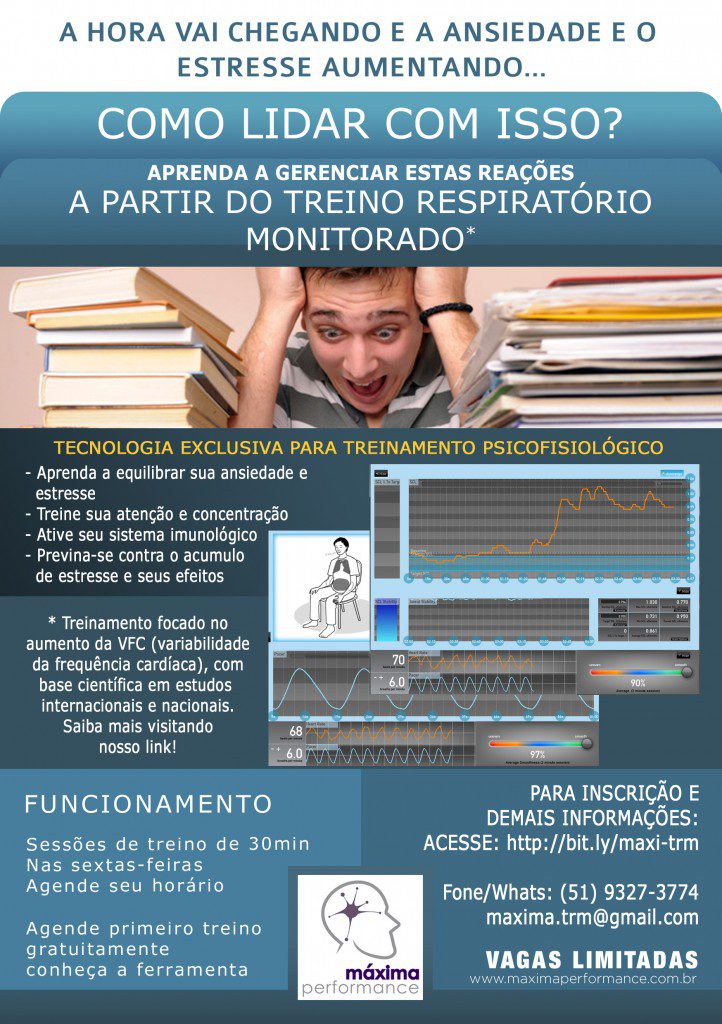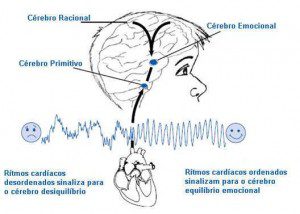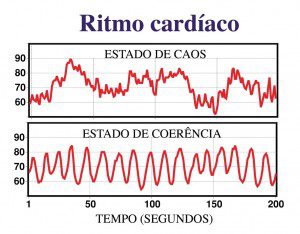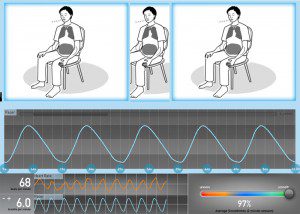É uma técnica que utiliza tecnologia de ponta para treinar a respiração, de maneira a obter a maior eficiência de cada indívíduo nesta atividade. Lembre-se, o objetivo é aumentar a VFC (Variabilidade da Frequência Cardíaca) através do treino respiratório e desta forma melhorar sua carga de Força de vontade.
A VFC, quando baixa, está correlacionada com baixo nível de homeostase (regulação inadequada do SNA – Sistema Nervoso Autônomo – Simpático x Parassimpático), aumento da VFC ativa o sistema imunológico e equilibra os sistemas Simpático e Parassimpático, diminuindo as consequências do estresse crônico (SNA Simpático muito ativado – predominantemente).
Homeostase corpórea e conexão cérebro-coração
O treinamento da respiração, realizado no seu melhor ritmo, conduz a um estado de coerência cardíaca que por sua vez melhora a fisiologia relacionada ao estresse como: pressão sanguínea, sistema imunológico, redução de ansiedade, cognição, recarga do estoque de sua força de vontade, entre outros benefícios.
O Treino Respiratório Monitorado ocorre através da utilização de um software específico com utilização de sensores que medem os batimentos cardiacos e a condutância da pele e permitem o treino visando aumentar o índice de VFC. Esta tecnica é conhecida como Biofeedback Cardíaco.
Desta maneira é possível treinar a respiração com o máximo de eficiência possível, usufruindo assim dos benefícios do treino de VFC (variabilidade da frequência cardíaca), que contribui para o equilíbrio e alivio do estresse, ansiedade, entre outros.
Se quiser saber mais, veja referências ao final deste post.
Serviço oferecido:

Referências:
Bhat, P. (2010). Efficacy of Alfa EEG wave biofeedback in the management of anxiety. Industrial Psychiatry Journal,19(2),111-114.
Bradley, R.T., McCraty, R., Atkinson, M., Tomasino, D., Daugherty, A & Arguelles, L. (2010). Emotion self-regulation, psychophysiological coherence, and test anxiety: results from an experiment using electrophysiological measures. Applied Psychophysiology and Biofeedback,35, 261-283.
Cutshall, S. M., Wentworth, L. J., Wahner-Roedler, D. L., Vincent, A., Schmidt, J.E., Loehrer, L. L., Cha, S. S. & Bauer, B. A. (2011). Evaluation of a biofeedback-assisted meditation program as a stress management tool for hospital nurses: a pilot study. Explore,7(2),110-112.
Éismont, E. V., Lutsyuk, N. V. & Pavlenko, V. B. (2011). Moderation of increased anxiety in children and teenagers with the use of neurotherapy: estimation of the efficacy. Neirofiziologiya/Neurophysiology,43(1),63-72.
Elkins, G., Fisher, W. & Johnson, A. (2010). Mind-body therapies in integrative oncology. Current Treatment Options in Oncology, 11,128-140.
Gervitz, R. N. & Dalenberg, C. (2008). Heart rate variability biofeedback in the treatment of trauma symptoms. Biofeedback, 36(1),22-23.
Hallman, D. M., Olsson, E. M., Schéele, B., Melin, L. & Lyskov, E. (2011). Effects of Heart rate variability biofeedback in subjects with stress-related chronic neck pain: a pilot study. Applied Psychophysiology and Biofeedback, 36,71-80.
Henriques, G., Keffer, S., Abrahamson, C. & Horst, S.J. (2011). Exploring the effectiveness of a computer-based heart rate variability biofeedback program in reducing anxiety in college students. Applied Psychophysiology and Biofeedback, 36,101-112.
Jordanova, N. P. & Gucev, Z. (2010). Game-based peripheral biofeedback for stress assessment in children.Pediatrics International, 52,428-431.
Kang, E. H., Park, J. E., Chung, C. S. & Yu, B. H. (2009). Effect of biofeedback-assisted autogenic training on headache activity and mood states in korean female migraine patients. Journal of Korean Medical Science, 24,936-940.
Lande, R. G., Williams, L. B., Francis, J. L., Gragnani, C. & Morin, M. L. (2010). Efficacy of biofeedback for post-traumatic stress disorder. Complementary Therapies in Medicine, 18,256-259.
Lazarov, A., Dar, R., Liberman, N. & Oded, Y. (2010). Are obsessive-compulsive tendencies related to reliance on external proxies for internal states? Evidence from biofeedback-aided relaxation studies. Behaviour Research and Therapy, 48,516-523.
McGrady, A. (2010) The effects of biofeedback in diabetes and essential hypertension. Cleveland Clinic Journal of Medicine, 77(3).
McKee, M. G. (2008) Biofeedback: an overview in the context of heart-brain medicine. Cleveland Clinic Journal of Medicine, 75(2).
McLay, R. N. & Spira, J. L. (2009) Use of a portable biofeedback device to improve insomnia in a combat zone, a case Report. Applied Psychophysiology and Biofeedback, 34,319-321.
Mikosch, P., Hadrawa, T., Laubreiter, K., Brandl, J., Pilz, J., Stettner, H. & Grimm, G. (2010). Effectiveness of respiratory-sinus-arrhythmia biofeedback on state-anxiety in patients undergoing coronary angiography. Journal of Advanced Nursing, 66(5),1101-1110.
Morarend, Q. A., Spector, M. L., Dawson, D. V., Clark, S. H. & Holmes, D. C. (2011). The use of a respiratory rate biofeedback device to reduce dental anxiety: an exploratory investigation. Applied Psychophysiology and Biofeedback, 36,63-70.
Nestoriuc, Y., Martin, A., Rief, W. & Andrasik, F. (2008). Biofeedback treatment for headache disorders: a comprehensive efficacy review. Applied Psychophysi ology and Biofeedback, 33,125-140.
Neves Neto, A. R. (2011) Técnicas de respiração para a redução do estresse em terapia cognitivo-comportamental. Arquivos Médicos dos Hospitais e da Faculdade de Ciências Médicas da Santa Casa, 56(3),158-68.
Paul, G., Elam, B. & Verhulst, S. J. (2007). A longitudinal study of students’ perceptions of using deep breathing meditation to reduce testing stresses. Teaching and Learning in Medicine, 19,287-292.
Paul, M. & Garg, K. (2012). The effect of heart rate variability biofeedback on performance psychology of basketball players. Applied Psychophysiology and Biofeedback, 37,131-144.
Shenefelt, P.D. (2010). Psychological interventions in the management of common skin conditions. Psychology Research and Behavior Management, 3,51-63.
Sherlin, L., Muench, F. & Wyckoff, S. (2010). Respiratory sinus arrhythmia feedback in a stressed population exposed to a brief stressor demonstrated by quantitative EEG and sLORETA. Applied Psychophysiology and Biofeedback, 35,219-228.
Slutsker, B., Konichezkya, A. & Gothelf, D. (2010). Breaking the cycle: cognitive behavioral therapy and biofeedback training in a case of cyclic vomiting syndrome. Psychology, Health & Medicine, 15(6),625-631.
Strunk, K. K, Sutton, G. W. & Burns. N. S. (2009). Beneficial effects of accurate and false brief. Biofeedback on Relaxation, Perceptual and Motor Skills, 109(3),881-886.
Wheat, A. L. & Larkin K. T. (2010). Biofeedback of heart rate variability and related physiology: a critical review. Applied Psychophysiology and Biofeedback, 35,229-242.
Zucker, T.L., Samuelson, K. W., Muench, F., Greenberg, M. A. & Gevirtz, R. N. (2009). The effects of respiratory sinus arrhythmia biofeedback on heart rate variability and posttraumatic stress disorder symptoms: a pilot study. Applied Psychophysiology and Biofeedback , 34(2),135-43.




Pingback: Você é feliz? | Sistema Máxima Performance